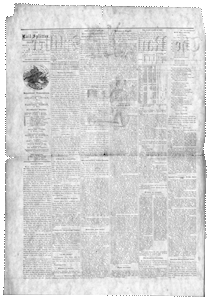Alamo Express [San Antonio, TX], August 25, 1860
We publish the following account of the “Fall of the Alamo” from the Texas Almanac for 1860. It is beyond a doubt the most authentic account extant. The writer was within almost stone-throw of the Alamo during the final assault, was in the fort immediately after, and as Alcalde of the town attended to burying the Mexican dead; was eye-witness to the burning of the bodies of the Texan heroes, and hunted out the bodies of Travis, Crockett and Bowie. Mr. Ruiz certainly ought to know the truth, and he is an honest truthful gentleman, the son of one of the signers of the declaration of Texas Independence. Capt. Potter, is entirely at variance with this account in some very essential particulars—in regard to the numbers, the assault, the resistance and the loss of life. According to Mr. Potter’s statement he was in Matamoras when the event happened and gathered his information from many incorrect sources, which consequently do not deserve the same credence as the statement of a Mexican gentleman of truth and intelligence, who was present and partook in some of the ceremonies of that heroic tragedy. Mr. Potter does not mention this account given by Mr. Ruiz, and will no doubt for the sake of history, make some very important corrections in his interesting reminiscence, when it is brought to his notice.
We wish to state that when we noticed Capt. Potter’s account we had merely glanced at it, and concluded, very naturally, that, coming from the gifted pen of Capt. Potter, it must be all its publishers claim for it; and besides we had not seen Mr. Ruiz’ account, which we repeat comes up with a better show of authority, than any we have yet seen.
The Fall of the Alamo, and Massacre of Travis and His Brave Associates.
By Francisco Antonio Ruiz.
On the 23d day of February, 1839, (2 o’clock P.M.) Gen. Santa Anna entered the city of San Antonio with a part of his army. This he affected without any resistance, the forces under the command of Travis Bowie, and Crockett, having on the same day, at 8 o’clock in the morning, learned that the Mexican army was on the banks of the Medina river, they concentrated in the fortress of the Alamo.
In the evening they began to exchange fire with guns, and from the 23d of February to the 6th of March (in which the storming was made by Santa Anna,) the roar of artillery and volleys of musketry were constantly heard.
On the 9th of March, at 3 o’clock P.M., Gen. Santa Anna at the head of 4,000 men, advanced against the Alamo. The infantry, artillery and cavalry had formed about 1000 varas. from the walls of said fortress. The Mexican army charged and were twice repulsed by the deadly fire of Travis’ artillery, which resembled a constant thunder. At the third charge the Toluca battalion commenced to scale the walls and suffered severely. Out of 800 men, only 130 were left alive.
When the Mexican army had succeeded in entering the walls, I, with the Political Chief (Gefe Politico) Don Ramon Murquiz, and other members of the Corporation, accompanied the Curate, Don Refugio de la Garza, by Santa Anna’s orders, had assembled [illegible] temporary fortification erected in Potrero street, with the object of attending the wounded, etc.—As soon as the storming commenced, we crossed the bridge on Commerce street with this object in view, and about 100 yards from the same a party of Mexican dragoons fired upon us and compelled us to fall back on the river and place we occupied before. Half an hour had elapsed when Santa Anna sent one of his aid-de-camps with an order for us to come before him. He directed me to call on some of the neighbors to come up with carts to carry the dead to the Cemetery, and also to accompany him, as he was desirous to have Col. Travis, Bowie, and Crockett shown to him.
On the north batter of the fortress lay the lifeless body of Col. Travis on the gun-carriage, shot only in the forehead. Toward the west, and in the small fort opposite the city, we found the body of Col. Crockett. Col. Bowie was found dead in his bed, in one of the rooms of the south side.
Santa Anna, after all the Mexicans were taken out, ordered wood to be brought to burn the bodies of the Texians. He sent a company of dragoons with me to bring wood and dry branches from the neighboring forest. About 3 o’clock in the afternoon, they commenced laying the wood and dry branches, upon which a file of dead bodies were laid; more wood was piled on them and another file brought, and in this manner they were all arranged in layers. Kindling wood was distributed through the pile, and about 5 o’clock in the evening it was lighted.
The dead Mexicans of Santa Anna were taken to the grave-yard, but not having sufficient room for them, I ordered some of them to be thrown into the river, which was done the same day.
Santa Anna’s loss was estimated at 1600 men. These were the flower of his army.
The gallantry of the few Texians who defended the Alamo was really wondered at by the Mexican army. Even the Generals were astonished at their vigorous resistance, and how dearly victory had been bought.
The Generals, who under Santa Anna participated in the storming of the Alamo, were Juan Amador, Castrillon, Ramirez, Sesma, and Andrade.
The men burnt numbered 182. I was an eye witness, for as Alcalde of San Antonio, I was with some of the neighbors collecting the dead bodies and placing them on the funeral pyre.
[Signed] Francisco Antonio Ruiz.
P.S. My father was Don Francisco Ruiz, a member of the Texas Convention. He signed the Declaration of Independence on the 2d of March, 1836.
